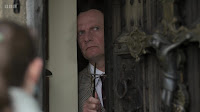Director: Carys Lewis
First aired: 2024
Contains spoilers
The programme Father Brown has featured on TMtV before and, like that time, Ian contacted me and told me that the latest episode of the programme had a vampire theme – though more so than last time.
The series is set in 1950s Britain, where the amateur sleuth is a Roman Catholic Priest, the eponymous Father Brown (Mark Williams, Being Human (UK)) and, to be honest, I’ve never watched it after the last episode I featured here.
 |
| at the grave |
In this we begin with a gentleman, Bernard Ross (Nicholas Woodeson), going through the nighttime graveyard and being spooked by bats. He gets to a grave and screams. Going to a phone box he makes a call and says that she (his daughter (Bethan Leyshon)) has risen as a vampire. The next day Father Brown is preparing for a requiem mass for said daughter when he is told that Ross is refusing to attend – he goes to his home.
 |
| crosses |
There the door is opened by Gilbert Gallamore (Nicholas Asbury), who is holding a cross (and there is one on the outside of the door also). Father Brown bustles his way in and Ross is convinced that his daughter is a vampire and Gilbert is equally convinced. Before she died, a year before, she had grown pale and ill, she had mood swings and blistered in the sun and eventually she committed suicide. She is buried on hallowed ground because the church deemed her not in her right mind.
 |
| Ray Fearon as Silas O'Hagen |
Evidence is a desiccated mouse (she’s been draining animals before working her way to humans) and the disturbed earth of her grave. Now… one might have asked why she had only just risen (as she has just started feeding small on mice) but the programme and protagonists do not. Equally, I’d have been concerned about the grave being dug up, if the soil was disturbed and the turf vanished – but the turf is not mentioned. Brown, of course, believes it to be poppycock but things are complicated when Silas O'Hagen (Ray Fearon) shows up, a vampire hunter returned from Romania, and a body appears with apparent fang marks in the neck.
 |
| hunter's kit |
The episode trades in movie tropes but that’s ok as the setting is late enough that sunlight, for instance, has entered the megatext and public perception. It also uses porphyria but in a way that makes sense and doesn’t try to tie it to folklore or suggest it was known as a vampire disease and actually tie it into the findings around the disease from the 1950s. It also has the vampire hunter selling apotropaic measures to a panicked village which was mildly amusing.
 |
| a daughter returned |
However, I’m sorry but the episode didn’t do it for me. I guess, as someone not invested in the series, then the series regulars meant very little and I found the figure of Brown sanctimonious (which he may be meant to be). The mystery was a tad vanilla, a moment with the daughter walking the halls was ill-explained (a dream, of course, but the dreamer’s reaction underwhelming). Whilst I know that now the Catholic Church will allow the burial of a suicide, and I don’t know for certain about the time period we are looking at, I found the idea that a 1950s priest knowingly allowed a burial of a suicide on church ground unlikely. Not for me, 4 out of 10.
The imdb page is here.
On Demand @ Amazon US
On DVD @ Amazon UK

















5 comments:
I'm currently reading a novel by G. K. Chesterton, whom I believe also invented the character of Father Brown (although I do not watch the series and have no idea how closely it follows the author's original intentions for this character).
Hi Jeff, that I can't really say as I haven't read the books and only seen the two vampire related episodes - I suspect given the length of the series that the character has developed past original intent but it really would be a wild guess with no evidential basis
I THINK that if person was not in right mind ie mentally Ill, he or she could be seen as someone not responsible for their own actions and buried in the hallowed ground.
WienBlood, I agree - nowadays... however it doesn't feel like something the church would allow in the 1950s. As I say I find it unlikely as I don't actually know, but the Catholic Church is hardly the bastion of progressiveness. Thanks for the comment though, you may be right
Yeah, when the Crown Prince Rudolf killed Maria Vetsera and himself, Vatican allowed it, but for the ordinary people?
Post a Comment